I spot a square, cream-coloured card on the bedside table in our room, “Le vrai gourmet,” it reads, “est celui qui se delecte d’une tartine de beurre comme d’un homard grillé.” It’s a quote from Colette (it states it, ahem, I’m not that learned); the true gourmet enjoys a buttered tartine as much as grilled lobster. It’s not the first time I’ve encountered such a motif in a hotel room, but it’s a curious sentiment for one. Typically, they’re idioms about luxury or rest or travel or suchlike. But then Chateau La Chenevière has a unique perspective on hospitality.
It’s not uncommon for a city hotel to house a fine restaurant – usually with a known name above the door – or, indeed, for a country inn, known for its food, to have rooms. But in this unassuming corner of the Normandy countryside, a few miles north of Bayeux, Chateau La Chenevière offers not one, but two restaurants which draw patrons for miles – even from across the Channel.
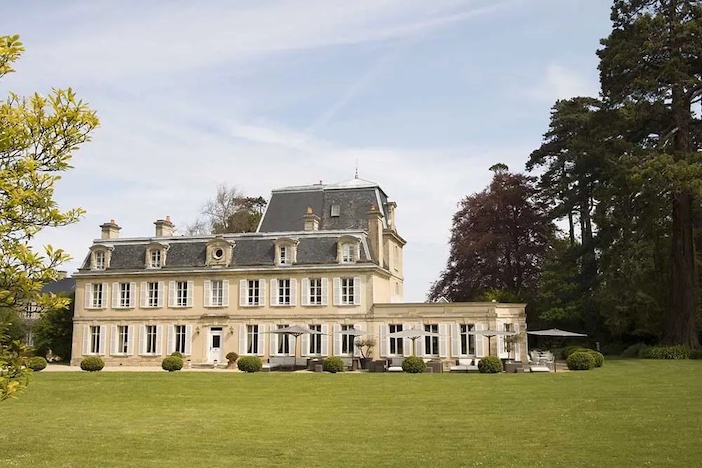
Down the gravel drive through the gates, it looks beautiful in the August sunshine, the light bouncing off its sand-coloured façade. The initial angle on the house is a tantalising glimpse until you walk across that beautifully clipped lawn to take it in; white window shutters, slate-tiled roof with gabled windows, so classically French.
It’s a garden, too, that someone pays careful attention to, so much so the trees have been documented on the hotel map, a homage to the botanical enthusiasm of a past owner. It’s a lovely garden – though at 12 hectares, ‘park’ is perhaps a more apposite description – to wander and relax in, through to a splendid, secluded pool and tennis court, neatly tucked away to prevent noise carrying – and, best of all, in my wanderings I stumbled across the ‘potager’. A kitchen garden, part of its farm-to-table philosophy, supplying fresh produce to the restaurants, including the honey and tea infusions available to guests.
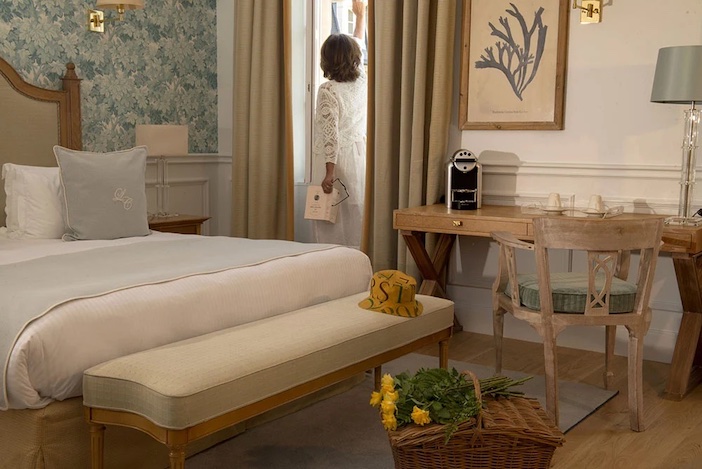
Chenevière is modest by chateau standards, but that makes it more intimate, and it’s furnished to be relaxing, inviting. There’s no ostentation, just simple good taste. Contemporary wallpapers and soft furnishings vie with antique touches; someone has taken care to appoint these rooms. The Diptyque toiletries are evidence of that, and the beds are, simply, exquisite.
In describing the countryside as ‘unassuming’ earlier, it is, of course, anything but. Just a few miles north of the hotel, 80 years ago this year, the most remarkable event in contemporary history took place, and beyond a sobering, contemplative visit to the Omaha cemetery, what’s more impressive – and equally moving – are the small tokens throughout the villages we’d drive through; street lamps with tributes to veterans, and village signs denoting when it was liberated and by which regiment.
Of course, a significant part of La Chenevière’s history is in living memory, too. It played its part in the war; occupied by Wehrmacht staff, it later had a pivotal role in the logistics of the post-Normandy landings. Something we managed to impart on our little nest of vipers, as a sobering dose of history aside from the thrill of the pool, although perhaps more engaging was the Bayeux Tapestry, something she could connect to having learned about Hastings earlier in the school year.
That history is also woven into the guest offering, naturally. Surveying the cocktail list before dinner, I spot the Juno and the Sword, but I opt for Le Resistant. Something about the smoky whisky and Chambord gives me gritty images of blowing up trains by torchlight, Galois in clenched teeth, in contrast to the pleasant setting of the hotel’s cosy bar.
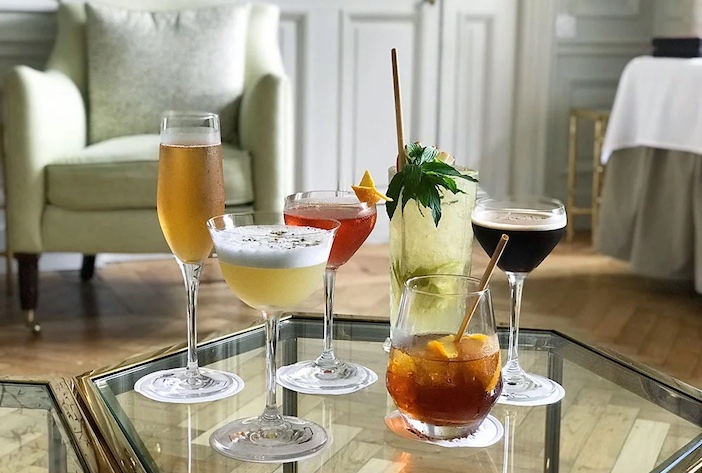
But what of those restaurants? Its signature, Le Botaniste, is in the main dining room; bathed in light cast from its floor-to-ceiling windows, crisp tablecloths and flashes of pastel-coloured bucolic images making for subtle references to their emphasis on produce and seasonality. And, for a boutique hotel, the team in the kitchen sets a precedent; Chef de Cuisines Didier Robin and his head chef Hugo Genty, both hailing from Normandy, have CVs riddled with Michelin stars.
The menu comprises a choice of tasting and seasonal offerings; the former is a flight through lobster, and features such confections as lobster and veal tartar, lobster and eggplant raviolo and the like, but since we know our meal is fuelled by the Potager, we’re keen to go a la carte – and it’s about as varied as you can make three courses. But first, no fine dining in France kicks off without an amuse, and we open with bite-size hazelnut tarts, carrot cake with duck and smoked haddock with apple purée. 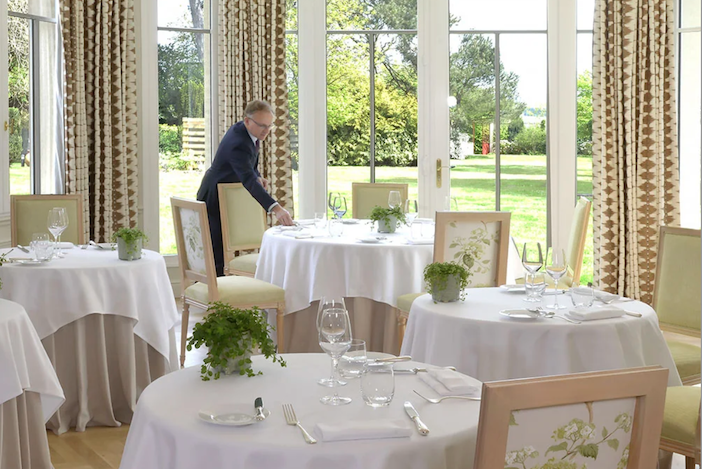
It’s not often our little nest of vipers joins us in fine dining, and bar the odd game of rummy to keep us amused between courses – pardon our manners – she gets into the swing of things rather well, complimenting the waiters and minding her Ps & Qs. She’s most impressed by the cloche, even when all its revealing is a bowl of penne. I suspect we may be adopting that little trick back home.
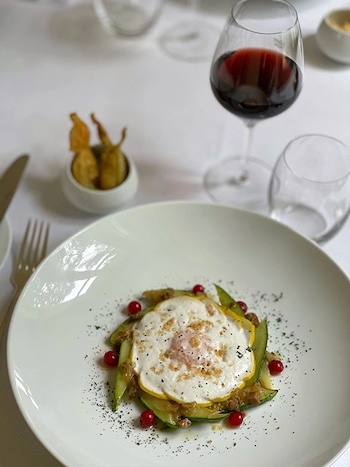 For us grown-ups, a choice of just three dishes per course may seem limited but the range make it impossible to make one’s mind up. A crab and verbena salad with apple foam are a light intro to the seabass poached in lemon balm for Mrs L. Sound choices to show off the garden’s fare, but something on the menu has me intrigued. An egg, soft-boiled in black tea, with peas suggests a dal of sorts, but it’s more than that; the flavours aren’t Asian; it’s essentially a pea broth with a flavoured egg, but to describe it so is a disservice. I genuinely think Genty has created a new dish.
For us grown-ups, a choice of just three dishes per course may seem limited but the range make it impossible to make one’s mind up. A crab and verbena salad with apple foam are a light intro to the seabass poached in lemon balm for Mrs L. Sound choices to show off the garden’s fare, but something on the menu has me intrigued. An egg, soft-boiled in black tea, with peas suggests a dal of sorts, but it’s more than that; the flavours aren’t Asian; it’s essentially a pea broth with a flavoured egg, but to describe it so is a disservice. I genuinely think Genty has created a new dish.
The menu, incidentally, is less a sheet of card, more a white leather-bound compendium that’s a paean to the team. They take their work very seriously here at Le Botaniste. The pastry chef is credited with ‘desserts by Simon Beauruelle’, and we couldn’t not conclude the meal with a millefeuille; this one featuring apricots and pesto. They are, truly, a suite of geniuses here. And we still had the cheese ‘chariot’ to come.
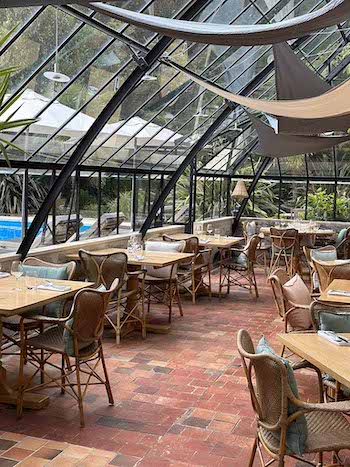 For lighter, more relaxed fare, there’s Le Petit Jardin, set in the conservatory by the pool. On fine summer evenings, one can dine al fresco on cast iron filigree tables in the garden. More relaxed it may be, but no less accomplished. Similarly, the menu is a celebration of the Potager and, again, making the freshest ingredients sing. A cauliflower steak, simply cooked in butter and sumac, is served on a bed of cottage cheese risotto (clever), but perhaps what makes this special is how they can take a French classic and elevate it into myth. An onion tart is pimped with a Calvados compote, but served with an onion sorbet. That’s right, sorbet. Of onions. I kid you not, this will diminish every other onion tart henceforth.
For lighter, more relaxed fare, there’s Le Petit Jardin, set in the conservatory by the pool. On fine summer evenings, one can dine al fresco on cast iron filigree tables in the garden. More relaxed it may be, but no less accomplished. Similarly, the menu is a celebration of the Potager and, again, making the freshest ingredients sing. A cauliflower steak, simply cooked in butter and sumac, is served on a bed of cottage cheese risotto (clever), but perhaps what makes this special is how they can take a French classic and elevate it into myth. An onion tart is pimped with a Calvados compote, but served with an onion sorbet. That’s right, sorbet. Of onions. I kid you not, this will diminish every other onion tart henceforth.
Speaking of Calvados – and sorbets – there’s a lovely touch, too, in Le Trou Normand; an apple and sorrel sorbet in a nod to a Normandy tradition where the patriarch of the house serves his home brew Calvados between dishes as a sort of palette cleanser. It should catch on back home.
For all the flourishes in the kitchen, and the delights of the setting, perhaps the most striking thing about Chateau La Chenevière is that it does all this effortlessly, with modesty, even humility. On our last night I asked the bartender which bar would be the better choice for an aperitif; I didn’t want to miss an opportunity to enjoy the hotel’s comforts again, but then was eager to try something new. He deftly tackled the question, “each are as enjoyable as the other, sir, it depends on what you are in the mood for.” To appreciate buttered tartine as much as grilled lobster, indeed.
Winner of Best Countryside Hotel in Europe by Small Luxury Hotels of the World in 2020, rooms at the 5* Chateau La Chenevière start at €308. For more information, including details of both Le Botaniste and Le Petit Jardin, as well as latest offers, and events such as the Plant Festival, please visit www.lacheneviere.com.




